|
May 19, 2006
Hello from Ottawa - Gatineau Park, A Four-Season
Playground Right On Ottawa's Doorsteps
After my visit to the Museum of Nature an adventure of an altogether
different nature was awaiting me: the outdoor splendour of Gatineau
Park, a large protected nature area measuring 361 square kilometres
whose southern tip is located literally 15 minutes north of Ottawa's
downtown area. The park itself is managed by the National
Capital Commission, an organization with a mandate and mission
to build the Capital region into a source of pride and unity for
Canadians.
To get a better overview of this facility I met Michel Dallaire,
Gatineau Park's Manager of Recreational Services who awaited me
in the lobby of the Visitor Information Centre, right next to a
big 3-dimensional topographical display of the Park.
Michel explained that Gatineau Park's most dominating topographical
feature is the Eardley Escarpment which is actually a former shoreline
of the Champlain Sea. The Park is a very popular destination: over
the last 25 years visitor numbers went from about 700,000 day visits
a year to more than 1,7 million currently. The National Capital
Region surrounding Ottawa is one of the fastest-growing areas in
the country and within the next 10 years about 2 million day visitors
are expected in Gatineau Park, and as a result the administration's
focus has changed from development to conservation.
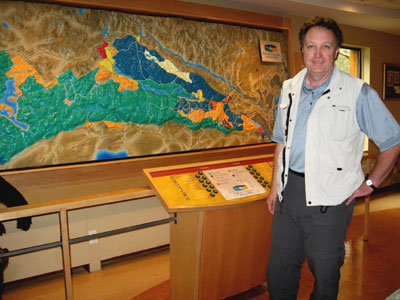
Michel explains the topography of the park to me
Gatineau Park offers a great variety of outdoor recreational opportunities:
in the summer months it offers camping opportunities on 3 different
campgrounds, more than 200 km of trails in the winter (including
cross-country and snow-shoeing trails) and 165 km of trails in the
summer which are multi-use and multi-seasonal. The parkways, scenic
roads in a natural setting, shut down every Sunday from late May
until Labour Day for bikers, roller-bladers and stroller-pushing
parents to enjoy the paved trails throughout the rolling hills of
Gatineau. There is even a downhill ski centre in Gatineau Park which
is called Camp Fortune. Michel explained that in the 1920s and 1930s
the Ottawa Ski Club started to develop a cross-country trail network
and later added a down-hill ski area. Ottawa's citizens used to
come here by train to take advantage of the winter adventures that
Gatineau Park has to offer.
This park fulfills a key role as a primary outdoor recreation area
for Ottawa's citizens and as a nature reserve for the entire capital
region. Michel explained that there have been 3 master plans over
the years for the park, and he has participated in them all since
he has more than 25 years of work experience with Gatineau Park.
The focus has shifted from developing the park to protecting its
greenspaces and focussing on its diverse eco-systems. The key question
has become how to manage the large number of visitors and provide
a great recreational experience while preserving this precious natural
resource for future generations of Canadians.
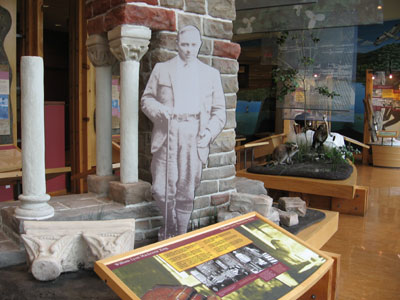
One of the historic displays inside the Visitors Centre
Four plans make up the current strategy for Gatineau Park: the
Conservation Plan addresses the protection of habitats and green
spaces while the Recreation Plan is favouring slightly different
styles of recreation, emphasizing more ecologically sustainable
activities. Motorized activities in the park will disappear over
time and activities such as rock climbing will face tighter restrictions.
The park managers collaborate closely with representatives from
different outdoor clubs and associations to ensure excellent buy-in
and collaboration. The Heritage Plan focuses on the architectural
and historic heritage of the park which includes, for example, former
Prime Minister William Lyon Mackenzie King's residence as well as
other historical buildings. Last but not least, the Green Plan endeavours
to tie in the park into a more overall ecologically sound master
plan by evaluating ways of connecting public transit to the park
as at this moment 95% of people come to the park by car. Park management
strives to make the entire Gatineau Park experience more environmentally
sustainable.
Michel next enlightened me on the types of trail systems available
in the park: in total more than 165 km of trails are availabe during
the summer throughout the park. Recreational pathways (about 15
km) are paved and accessible to users of bicycles, in-line skates
and strollers. About 90 km of shared use trails are built of mulch,
gravel or hardened clay and are used by mountain-bikers and hikers,
and hiking trails are for pedestrian use only. 30 km of parkways
are closed to road traffic regularly to give non-motorized wheeled
athletes a chance to enjoy themselves without road traffic and exhaust
fumes. It takes about 20 minutes by bike from Parliament Hill to
the southernmost entrance of Gatineau Park, an example of how accessible
the park is to all the urban residents of Ottawa and its surroundings.
Every Sunday from late May to Labour Day, more than 30km of park
roads are blocked off to vehicular traffic for the Alcatel Sunday
Bikedays and made accessible to bikers and inline skaters.
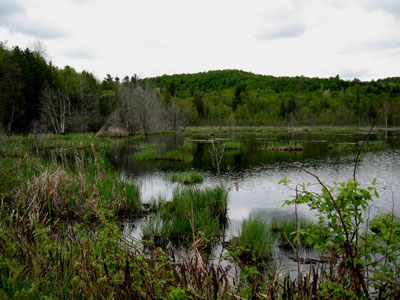 | |
A pond, created by a beaver dam
Camping is also an important feature of Gatineau Park, and the
camping experience covers everything from big, luxurious RVs to
wilderness camping. Around Lac Philippe there is a family camping
area with a variety of facilities while the area around Taylor Lake
is more remote and provides a semi-wilderness experience. The La
Pêche area is intended for canoe-camping and you literally
have to use a canoe to get into this area. Harrington Lake is the
location of a prime ministerial residence and as a result it is
a high-security area that is not accessible to the public.
Following this general overview, Michel packed me into one of the
fuel-conserving official Gatineau Park vehicles and off we went
for a brief visit of the park. We went on the main road and Michel
pointed out the turnoff to Meech Lake, site of the (in)famous Meech
Lake Accord, a set of failed constitutional amendments to the Constitution
of Canada negotiated in 1987, designed to persuade Quebec to accept
the Canada Act. Indeed, Gatineau Park has an important place in
the history of Canada.
Nowhere is this in evidence more than at the Mackenzie Estate,
former prime minster Mackenzie King's private estate. William Lyon
Mackenzie King (1874 to 1950) was the tenth Prime Minister of Canada
and governed during three different periods with intermissions of
different lengths from late 1921 to late 1948. His combined time
is the longest of any Prime Minister in the history of Canada and
in 1999 Mackenzie King was ranked by historians as the greatest
of Canada's Prime Ministers.
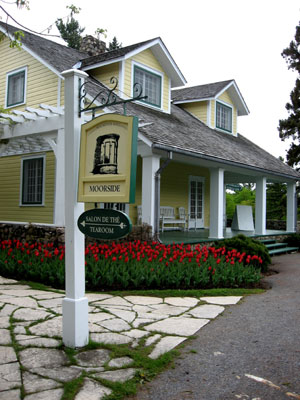
Moorside, part of the Mackenzie King Estate, now the location of
a tea room
In 1903 Mackenzie King bought land near Kingsmere Lake and built
a modest cottage for himself. After he became prime minister, he
moved to a larger residence where he laid out ornamental English
gardens and ruins. His permanent residence was an old restored farmhouse,
"The Farm", which was his last residence and now serves
as the official residence of the Speaker of the House of Commons.
Upon his death in 1950, he bequeathed his property at Kingsmere
to the people of Canada.
At the Mackenzie King Estate, Michel and I met Chantal Comeau who
works for the National
Capital Commission (NCC), the federal agency responsible for
planning and building a capital of which all Canadians can be proud.
The NCC also organizes national celebrations and events, including
Canada Day and Winterlude.
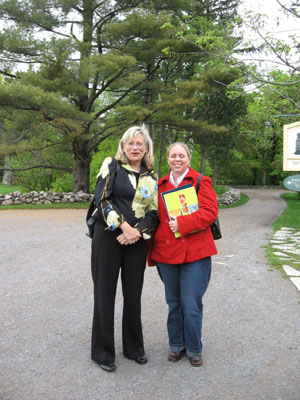
Dorota and Chantal explain the science of tulips to me
The planting of the tulips for Ottawa's world-famous Tulip Festival
is also managed by the National
Capital Commission, and each spring, more than one million tulips
and 200,000 daffodils bloom in the NCC's flowerbeds. Ottawa's
Tulip Festival has interesting historic roots: at the beginning
of World War II, Princess Juliana of the Netherlands and her family
found refuge in Canada, and five years later, Canadian troops liberated
her native country. As a gesture of gratitude, the Dutch people
sent 100,000 tulips bulbs to Canada, and another 20,000 were added
by the Dutch royal family. This tradition continues and every year
the Netherlands send 20,000 bulbs to Canada.
Chantal brought a tulip expert with her: Dorota, who is the head
landscape architect handling the planting of tulips for Ottawa's
Tulip Festival. Interestingly and quite humorously, Dorotha is called
the "bulb lady" because she not only plans all the planting
of the tulip bulbs for Ottawa, she also handles the design of the
light bulbs for Ottawa's Christmas Light festival.
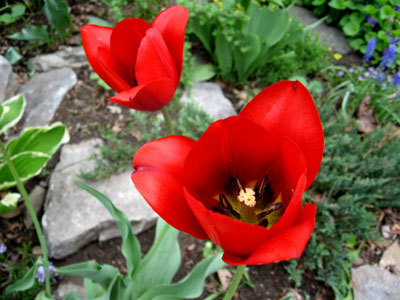
One of the late-blooming specimens at the Mackenzie Estate
Kingsmere was just covered in late-blooming tulips and Dorotha
gave me an overview of the over 50 different varieties of tulips
that are used in Ottawa's famous Tulip Festival. They vary in size,
colour, shape and blooming time and once they are finished blooming,
they are composted and replaced by annual flowers that adorn the
NCC's locations.
My brief exploration of Gatineau Park had come to an end since
I had a television interview to prepare for, but it gave me a taste
of this historic nature area that is so easily accessible to everyone
in the National Capital Region and I thought to myself that next
time I come here I have to bring my mountain bike (or my cross-country
skis, depending the season).
Related Articles:
Hello from Ottawa
- Overview of my first excursion to Ottawa's Tulip Festival
Hello from Ottawa - Arrival,
two photo exhibitions and my own photo safari
Hello from Ottawa - Doubling up
on antiquity at the Canadian Museum of Civlization
Hello from Ottawa - Sweetgrass Bistro:
Aboriginal dining in the ByWard Market
Hello from Ottawa - The historic
McGee's Inn: 2 couples embark on the adventure of joint B&B
ownership
Hello from Ottawa - The Canadian
Museum of Nature and Fatal Attraction: seduction in the
animal world
Hello from Ottawa - Gatineau Park,
Ottawa's nature playground
Hello from Ottawa - Major's Hill
and a live TV interview
Hello from Ottawa - Bistro 115: Authentic
French-Canadian cuisine in the ByWard Market
Hello from Ottawa - Historic transportation
on the Hull-Chelsea-Wakefield Steam Train
Hello from Ottawa - The Wakefield
Mill Inn & Spa: from historic gristmill to upscale lodging,
dining and pampering
Hello from Ottawa - Flower
and dress design at the Casino du Lac-Leamy
Hello from Ottawa - The Flotilla
- a parade of decorated boats - and an interview about the background
of the Tulip Festival
Hello from Ottawa - Sheep shearing
at the Canadian Agriculture Museum
Hello from Ottawa - Tractors,
cows and small animals at the Canadian Agriculture Museum
Hello from Ottawa - My 2-day
packed itinerary for Winterlude
Hello from Ottawa - First
impressions and an overview
Hello from Ottawa - The Lord Elgin
Hotel: a historic landmark in the heart of Ottawa
Hello from Ottawa - Fat Tuesday's
and the Mardi Gras Experience in the ByWard Market
Hello from Ottawa - An early
morning walk to Parliament Hill
Hello from Ottawa - Skating
on the Rideau Canal, the World's Largest Skating Rink
Hello from Ottawa - Charity and
hilarity: the 26th Annual Bedzz Races on Dow's Lake
Hello from Ottawa - Confederation
Park and other Winterlude locations
Hello from Ottawa - Darcy McGee's:
a historic Irish pub on Sparks Street
Hello from Ottawa - The Canadian
War Museum and "Weapons of Mass Dissemination - The Propaganda
of War"
Hello from Ottawa - The
Canadian Museum of Contemporary Photography featuring Sunil Gupta
and the challenges of immigration
An interview with Tourism Ottawa
provides a great overview of this city
An interview about
the ByWard Market, a prime entertainment and shopping area
An interview
with the National Gallery of Canada
An interview
with the Canadian Museum of Civilization
Helpful websites:
Ottawa
Tourism: Ottawa's official tourism information
The ByWard
Market Business Improvement Area
The
National Capital Commission
The National
Museum of Civilization
The National Gallery
of Canada
The Canadian War
Museum
The Canadian Museum
of Nature
The
Canadian Agriculture Museum
Useful books about Ottawa:
|